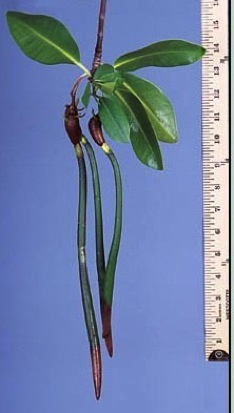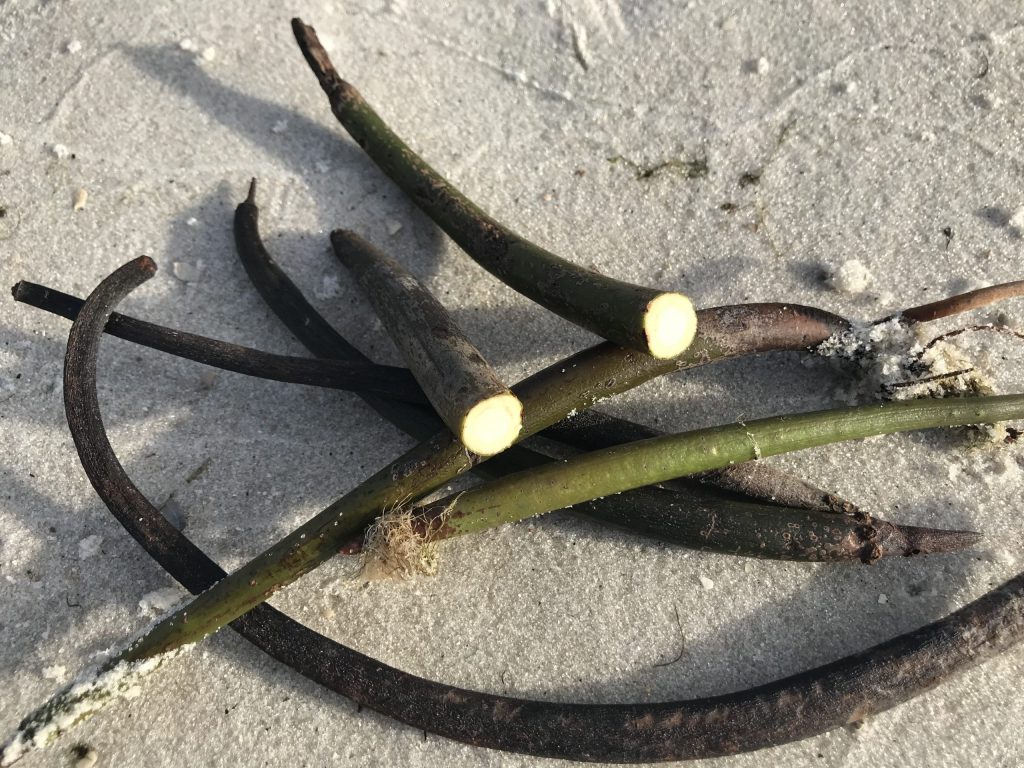
The inner starch of red mangrove propagules is edible cooked. Photo by Green Deane
Mangroves: Marvelous Muck Masters
I did an unknown favor close to 30 years ago that may stump some stuffy botanist in the near or distant future, and a mangrove helped me.
Mangroves are coastal trees that don’t mind wet salty feet. Well… that’s not exactly accurate. They tolerate salt. The Red Mangrove is found at or in the water, and endures flooding. The Black Mangrove is found just above the water and can take occasional flooding well.
Many years ago I lived in the center of the state (Florida) in an apartment complex that had swales. One particular swale always flooded and what ever bush the complex planted there died. On one of my foraging trips I brought back a Black Mangrove seedling, raised it a bit on my balcony then planted it with a stake in the wet spot. When last I checked it was still happily growing 26 years later. Mangroves used to grow inland in ancient times but have been coastal dweller for eons. I can’t help but wonder if some day some researcher will find that tree, or its remains, and wonder how it got so far inland.
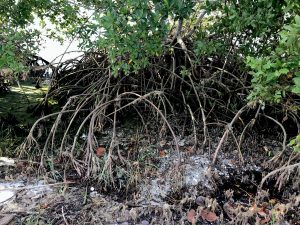
Red Mangrove roots help the tree “walk.”
The Red Mangrove is Rhizophora mangle (rye-ZOFF-for-ruh MAN-glee.) When one mentions costal bushes walking on water it’s the Red Mangrove that comes to mind. Their seed pods litter the beaches at certain times of the year. In central Florida they are bushes but the farther south one goes towards the equator the larger they become eventually reaching tree status. Its dried leaves make a nice tea with tannin, 11.68% tannin. The same leaves have also been used as tobacco and make wine, as can young fruit. Further, its fruit is actually not a fruit at all but a propagule, an embryonic root. It starts out as a bud but grows somewhat like a curved, thin-ringed cigar and when dry can be smoked like one, if you snip off each end. You can also make a whistle out of it. The bitter inner portion of the same hypocotyl when green can be eaten as an emergency food cooked well in a lot of water. By the way, they can float for a year in salt water before rooting. Recent research shows extracts made from the bark of the Red Mangrove can reduce gastric ulcers, is antimicrobial and contains antioxidants. Red Mangrove twigs can be used to clean teeth.
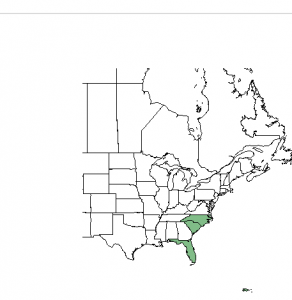
Red Mangrove distribution.
The leaves made into a meal make good cattle food (if calcium carbonate is added) and are 7.5% protein, 3.6% fat, 13.9% fiber and 2.8% carotene. Per 100 grams the leaf meal has 1.35 grams of calcium, 0.88 grams magnesium, 0.65 grams potassium, 0.14 grams phosphorus, 54 mg of iodine, manganese 30 mg, 15 mg of iron, 4.3 mg of zinc, 3.5 mg of copper, ,13 mg of B1 (thiamin) 19 mg of B2 (riboflavin) B3 (niacin) 240 mg, B5 (pantothenic acid 5.3 mg) 32 mg of B9 (folic acid) 0.52 mg cobalt and 46 mg of choline. Amino acids in descending amounts were arginine, lysine, glycine, methionine and cystine.
Supplemental 106 grain tablets were made of red mangrove leaves in the early 1950s. An analysis showed per 100 grams they had calcium 1.35 grams, iodine 53.60 mg, magnesium 880 mg, phosphorus 138 mg, potassium 650 mg, sulphur 790 mg, copper 8.30 mg, sodium 920 mg, zinc 4.30 mg, iron 15.20 mg, manganese 30 mg, boron 8.30 mg chlorophyll 2.24 mcg per gram, folic acid 0.68 mcg per gram, cobalt 5.20 ppm, fluorine 144 ppm and crude fiber 10.3%.
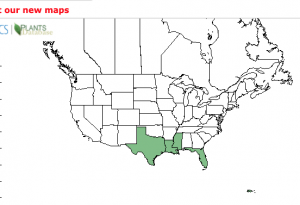
Black Mangrove distribution.
The leaves at one time were considered a source material once for human protein but that was sidelined by the plants high tannin content.
Its botanical name, Rhizophora mangle, is in part from Greek and part Taino. Rhizo means root; phora, from pherein, means to bear. Mangle (via Potuguese) comes from the word, mangue, which is what the Taino called the Red Mangrove. The word “mangrove” also comes from mangue.

Black Mangroves propagules are edible, too.
The sprouting propagules of the Black Mangrove, Avicennia germinans, (av-ih-SEN-ee-uh JER-min-ans) can also be used as a famine food, if cooked. They are toxic raw and resemble huge pointed lima beans. The Black Mangrove’s leaves are often coated with salt, which makes collecting convenient should you be needing salt. Avicennia means “of Avicenna.” Avinenna was an Arabian physician in the tenth century AD. The genus was named after him. Germinans is germinating, starting to root while on the tree.
Traditionally nothing is edible on the White Mangrove, Laguncularia racemosa, la-gun-koo-LAY-ree-uh ray-sem-OH-sa.) Its bark has a long herbal history for treating various ailments. The shurb’s high tannin content makes it astringent. It was used as a fever tonic to treat scurvy, dysentery, and skin ulcers. It is reported to have anti-tumor activity. Enthobotanical studies do not show native Indians eating the leaves of the White Mangrove in the Northern Hemisphere. There is a report (Hocking 1997) that the leaves are boiled for greens in Scandinavia and Great Britain. Since they do not grow there they must be imported. Laguncuiaria means like a Lagunculo, for its flask-shaped seed. Racemosa is racime-like, think of a flower spike shaped like a tail.

White mangrove fruit are not edible.
And the poor Buttonwood, Conocarpus erectus, (kawn-oh-KAR-pus ee-RECK-tus) never viewed on its own. The Buttonwood makes a nice landscape tree, is high in tannin and can be used to make a smokeless, high grade charcoal. The wood of the C. erectus and C. erectus var. sericeus can be used to smoke fish and meat. Conocarpus means cone shaped fruit and erectus, upright. Sericeus (suh-REE-see-uhs) means silky.
Warning: In Australia there is a white mangrove (Excoecaria agallocha) the sap of which can make you blind.
Green Deane’s “Itemized” Plant Profile
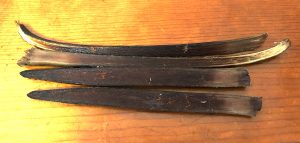
Red Mangroves propagule cooked.You scrape out the starch-like material.
IDENTIFICATION: The Red Mangrove has cigar-like fruit and ovate to lanceolate leaves slightly wider at the end. The Black Mangrove, also called the Honey Mangrove, has seeds that resemble gigantic lima beans and small ovate leaves.
TIME OF YEAR: Mangroves can seed all year but they favor spring. As evergreens the leaves are available year round.
ENVIRONMENT: If you’re not standing in smelly tidal muck with all kinds of insects bothering you you are not in the right environment. Salty coastal areas of salt and brackish water.
METHOD OF PREPARATION: Red: leaves for tea, smoking or wine, fruit for wine, smoking, inner starchy core for survival food. Black: Sprouting seeds boiled, salt off leaves.

